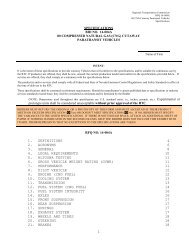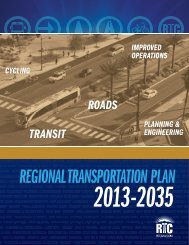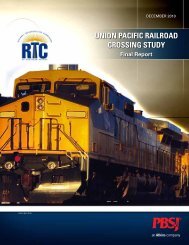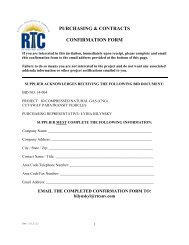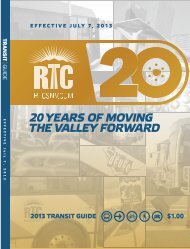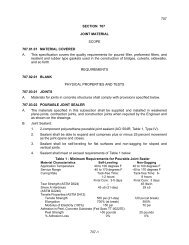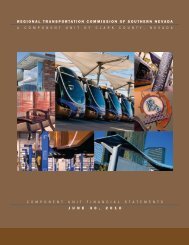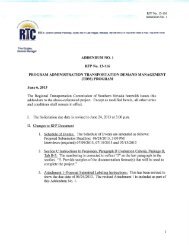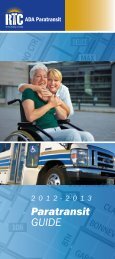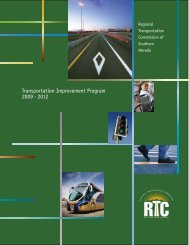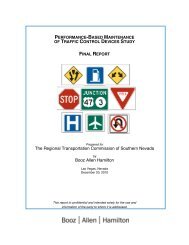(Blue Diamond Road) Corridor Study - Regional Transportation ...
(Blue Diamond Road) Corridor Study - Regional Transportation ...
(Blue Diamond Road) Corridor Study - Regional Transportation ...
You also want an ePaper? Increase the reach of your titles
YUMPU automatically turns print PDFs into web optimized ePapers that Google loves.
2. Current Conditions of <strong>Study</strong> Area RTC SR-160 <strong>Corridor</strong> <strong>Study</strong><br />
2.8.2 Congestion Index<br />
The noted transportation engineer, Morris J. Rothenberg, defines urban highway congestion<br />
as "a condition in which the number of vehicles attempting to use a roadway at any given<br />
time exceeds the ability of the roadway to carry the load at generally acceptable service<br />
levels.”5<br />
There are two types of congestion: recurring and non-recurring. Typically, recurring<br />
congestion occurs during the morning and afternoon rush hours as commuters travel to and<br />
from work. Nonrecurring congestion is caused by random incidents, most often disabled<br />
vehicles and accidents.<br />
Different methods are used to determine a service level for each component of a<br />
transportation network. In general, the capacity of a street is a measure of its ability to<br />
accommodate a certain volume of moving vehicles. Typically, street capacity refers to the<br />
maximum number of vehicles that a street element (e.g. an intersection) can be expected<br />
to accommodate in a given time period under the prevailing roadway and traffic conditions.<br />
On a typical county road like SR-160, lane capacities are normally in the range of 1,400 to<br />
1,600 vehicles per hour.<br />
One important deficiency related to congestion and the overall level of service provided to<br />
roadway users is the Volume to Capacity Ratio (V/C). As the volume of traffic increases,<br />
the density of vehicles increases as well as throughput, reaching a maximum flow rate when<br />
volume equals capacity (V/C ratio equal to one). Past that point conditions break down<br />
rapidly and delays increase (V/C ratio of over one).<br />
The methodology for determining congested corridors for this study was to compare the<br />
corridor's V/C ratio to a V/C ratio threshold. The impact of volume is different for different<br />
roadway types (minor arterials, major arterials, highways, freeways, etc.), so thresholds<br />
were established to account for these differences. The thresholds were determined by a<br />
technical working group of the Congestion Management System project and differ by<br />
functional class and area type types.<br />
2.8.3 Level of Service (LOS)<br />
The concept of levels of service (LOS) is well established in highway capacity analysis. LOS<br />
is a quantitative measure that compares the vehicle flow of traffic with the vehicle capacity<br />
available. The resulting volume to capacity ratio (VCR) is then classified in one of six levels<br />
of service. A LOS is an “A, B, C D, E, or F” grading system that rates the quality of<br />
5 Rothenberg, Morris J., "Urban Congestion in the United States: What Does the Future Hold", ITE Journal,<br />
Volume 55, Number 7, July 1985, pp. 22-39.<br />
2-19



